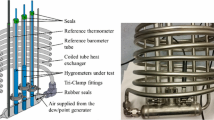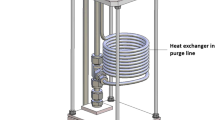Abstract
Techniques for the evaluation of the spatial temperature and humidity performance criteria of climatic chambers are described within the various sections of the International Electrotechnical Commission (IEC) Standard IEC60068 applicable to environmental testing. This paper involves the comparison of three common measurement systems used to assess the performance of climatic chambers, as well as the development of methods for determination of uncertainty contributions, and subsequent propagation into an uncertainty analysis for each method. Methods for validating the performance of these chambers should include specific uncertainty contributions, such as fluctuations, homogeneity, radiation, sampling, and loading effects. These effects are discussed and evaluated as part of this work. The procedure, as detailed in IEC60068, was followed using a chilled-mirror dew-point hygrometer with nine platinum resistance thermometers, nine calibrated RH (relative humidity) and temperature probes, and nine calibrated RH and temperature wireless data logger modules. Loading effect and dew-point uniformity were evaluated empirically and the results discussed. A summary of the results obtained and the associated uncertainty calculations are described and compared. All three systems have their merits, and lower uncertainties in both temperature and %rh were obtained for the chilled-mirror system.




Similar content being viewed by others
Abbreviations
- Loading effect::
-
The difference in temperature at any one point due to the presence of a load in the chamber space
- Radiation effect::
-
Differences in the measured temperature due to the absorption or emission of different levels of thermal radiation by the temperature sensors
- Dew-point uniformity::
-
The amount of variation in the dew-point temperature within the test space, equivalent to water vapor-pressure uniformity
- Gradient::
-
Maximum difference in mean value, after stabilization at any moment in time between two separate points in the working space.
- Fluctuation::
-
Change (from the mean) in temperature or humidity after stabilization from time to time at a point in space. (note: it may be expressed as the standard deviation or maximum deviation. The standard deviation was used in this work)
References
Environmental Testing Confirmation of the Performance of Temperature Chambers. CEI-IEC 60068-3-5 (International Electrotechnical Comission (IEC), Geneva, Switzerland, 2001)
Environmental Testing Confirmation of the Performance of Temperature/Humidity Chambers. CEI-IEC 60068-3-6 (International Electrotechnical Comission (IEC), Geneva, Switzerland, 2001)
T. Sinhaneti, T. Keawprasert, U. Norranim, Comparison of Calibration Methods of Climatic Chamber (poster presentation); http://www.nimt.or.th/nimt/upload/contentfile/sys-lab_magazine-595-433-en (accessed Sept. 2013)
M. White, D. Mac Lochlainn, in Proceedings of Ninth International Temperature Symposium (Los Angeles), Temperature: Its Measurement and Control in Science and Industry, vol. 8, ed. by C.W. Meyer, A.I.P. Conference Proceedings 1552 (AIP, Melville, NY, 2013), pp. 857–862
Deutscher Kalibrierdienst 2004, Calibration of Climatic Chambers, DKD-R 5–7 2004. English Translation (2009). Available from: http://www.dkd.eu/dokumente/Richtlinien/dkd_r_5_7_e.pdf (accessed Sept. 2013)
Environmental Testing—Supporting Documentation and Guidance—Measurements in Temperature Chambers for Tests A and B (with Load). CEI-IEC 60068-3-7 (International ElectrotechnicalComission (IEC), Geneva, Switzerland, 2001)
Environmental Testing, Calculation of Uncertainty of Conditions in Climatic Test Chambers, CEI-IEC60068-3-11 (International Electrotechnical Comission (IEC), Geneva, Switzerland, 2007)
U.S. Department of Defence Test Method Standard: Environmental Engineering Considerations and Laboratory Tests, MIL-STD-810G (Aberdeen Proving Grounds, Maryland, 2008)
D. Sonntag, Z. Meteorol. 40, 340 (1990)
Euramet Technical Committee for Thermometry, Calibration of Climatic Chambers, Guidance for Calibration Laboratories cg-20 Version 3.0 (Braunschweig, Germany, 2011)
Acknowledgments
This work was supported in part by all the organizations and companies involved, and the authors on behalf of their organizations thank the other participating organizations for their contribution toward developing a wider understanding of the methods of measurement, test procedures, data analysis, and system integration.
Author information
Authors and Affiliations
Corresponding author
Rights and permissions
About this article
Cite this article
Mac Lochlainn, D., White, M., Wettstein, S. et al. A Comparison of Climatic Chamber Hygrothermal Characterization Techniques as Described in IEC60068. Int J Thermophys 36, 2199–2214 (2015). https://doi.org/10.1007/s10765-015-1889-0
Received:
Accepted:
Published:
Issue Date:
DOI: https://doi.org/10.1007/s10765-015-1889-0




